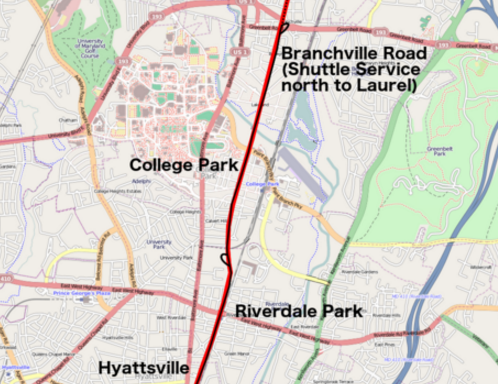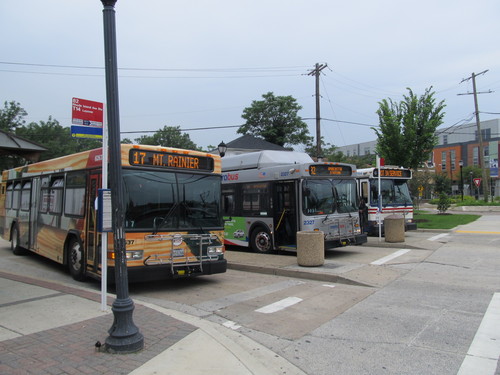A streetcar used to run down Rhode Island Avenue, connecting College Park and downtown DC
Most of Washington’s original “streetcar suburbs” were built within the District’s boundaries. However, one important corridor of streetcar suburbs went up in Prince George’s County, in the communities along Route 1 south of the Beltway.

A map of the route of the Rhode Island Avenue streetcar in Prince George’s County to Branchville Road. North of Branchville road, an hourly single-track shuttle service ran to Laurel until it was abandoned in 1925. Map by the author using OpenStreet Map. Click for a larger version.
A streetcar from Baltimore to Washington?
While steam railroads had linked Baltimore to Washington for half a century, the introduction of electric streetcars in Baltimore in 1885 and Washington in 1888 led to interest in the idea of an electric interurban line to link the two cities.
In 1892, the Columbia and Maryland Railway was chartered by a group of businessmen who hoped to construct an electric streetcar line from Baltimore to Washington by way of Ellicott City, Laurel, and Hyattsville. Called the Washington, Berwyn & Laurel, this line roughly paralleled the route of the B&O line (now the MARC Camden Line) between the two cities. The businessmen expected that the growth of suburbs would create a “great country city” along the route and provide enough traffic to justify the construction of a new rail line and adjacent roadway.
Although the plan as a whole never came to fruition, tracks were built along Rhode Island Avenue from 4th Street NE to a station called District Line, where there was a loop for streetcars to turn around, at 34th Street in Mount Rainier, Maryland (today, it’s a bus loop). From there, the line continued to Laurel, leaving a gap of twenty miles to the Elliott City terminus of the Baltimore streetcar line it had been intended to connect to.

34th Street Terminal: the short-turn loop at 34th St in Mt. Rainier still exists, and is used by several WMATA and Prince George’s County bus routes. Photo by the author.
The Route 1 suburbs and the streetcar
Service on the line to Mt. Rainier began in 1897 and, by September 1900, the line—now called the City and Suburban—provided half-hourly service from Branchville Road (just north of what is now Greenbelt Road in College Park) along Rhode Island Avenue and New York Avenue to the Treasury Building at 15th Street NW.
Several years later, a single-tracked line was extended to Laurel and served by an hourly shuttle. Shortly afterward, the line was merged into the Washington Railway and Electric Company, one of the District’s two major streetcar systems, and became known as the “Maryland Line.”
Rhode Island Avenue was extended north alongside the streetcar tracks to the Hyattsville rail station, located near the current county court building. North of Hyattsville, the streetcar stayed close to the railroad as it passed through what was still the Calvert family estate. From the line’s entrance into what is now College Park to its northern terminus in Laurel, it again largely followed its own private right-of-way.
The residential developments that became Mt. Rainier, Brentwood, North Brentwood, Riverdale, and much of College Park were built along the Maryland Line while the areas around them remained farmland. Up until World War II, the streetcar line into DC was central to the sale of homes in these new communities.
Rise of the roads
The rise of the automobile, which began in the 1920’s, changed the nature of the streetcar route and the communities along it.
US Route 1 was eventually switched from its original alignment along Baltimore Avenue and Bladensburg Road to follow Rhode Island Avenue into the District, and the stretch of Baltimore Avenue south of this junction, which had been a major commercial strip in Hyattsville and Bladensburg, gradually decayed and became home to light industrial uses.
North of the junction with Baltimore Avenue, Rhode Island Avenue was not extended consistently along the streetcar tracks, but disconnected segments of residential streets alongside the track were built and took on the same name. In the last decade, College Park and Riverdale have constructed a multi-use trail along this right-of-way, connecting previously disconnected neighborhoods.
The never-popular shuttle to Laurel was terminated in 1925, resulting in the construction of Rhode Island Avenue as an arterial road in the former right-of-way from Branchville Road north into Beltsville. However, service from downtown to Branchville became Capital Transit’s route 82 and continued until 1958, only four years before the end of streetcar service in Washington.
